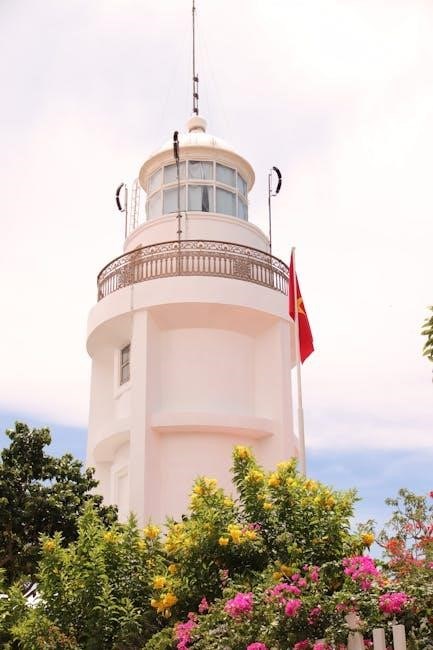Understanding USDA Hardiness Zone 10a
USDA Hardiness Zone 10a has a minimum temperature range of 30°F to 35°F (-1°C to 2°C), ideal for plants requiring warmth. The long growing season supports year-round gardening.
Temperature Range and Growing Season
USDA Hardiness Zone 10a is characterized by a warm climate with a minimum temperature range of 30°F to 35°F (-1°C to 2°C). This zone enjoys a long growing season, typically lasting year-round, with the last frost date occurring as early as late January and the first frost date as late as early December. The prolonged warm weather allows gardeners to plant a wide variety of crops throughout the year. The mild winters and hot, humid summers make it ideal for growing tropical and subtropical plants. This unique climate provides ample opportunities for multiple harvests and continuous growth, making it a paradise for gardeners.
Importance of Zone 10a for Plant Selection
USDA Hardiness Zone 10a plays a crucial role in plant selection due to its warm, subtropical climate. The zone’s mild winters and long growing season allow gardeners to grow a wide variety of plants that cannot survive in colder zones. Understanding Zone 10a’s temperature range ensures gardeners choose plants suited to its conditions, avoiding species that may not thrive or survive. This knowledge helps in selecting tropical and subtropical plants like Bird of Paradise, Plumeria, and Croton, which flourish in Zone 10a’s climate. Proper plant selection enhances garden success, reduces failure risks, and maximizes the beauty and productivity of the garden year-round.

Best Plants for Zone 10a
Zone 10a is ideal for tropical and vibrant plants like Bird of Paradise, Plumeria, and Lantana. It also supports thriving vegetables, herbs, and colorful flowers year-round. 🌺
Vegetables
Gardening in Zone 10a offers a year-round opportunity to grow a variety of vegetables. Cool-weather crops like spinach, lettuce, broccoli, and carrots thrive during the cooler months. In warmer seasons, plant heat-tolerant vegetables such as tomatoes, peppers, cucumbers, and beans. Root vegetables like radishes and beets also grow well. With proper planning, gardeners can enjoy multiple harvests throughout the year. Rotate crops to maintain soil health and prevent pests. Incorporate compost and fertilizers to optimize growth. Planting schedules should align with the region’s mild winters and hot summers to ensure the best results for each vegetable type.
Flowers
Zone 10a’s warm climate is perfect for vibrant, tropical flowers. Bright blooms like hibiscus, plumeria, and bird of paradise add exotic beauty to gardens. Lantana, marigolds, and zinnias thrive in full sun, while impatiens and coleus prefer partial shade. Year-round flowering is achievable with proper selection. Use compost-enriched soil for healthy growth. Regular watering and deadheading encourage continuous blooming. Incorporate native flowers like California poppies to attract pollinators. With minimal frost concerns, gardeners can enjoy colorful displays throughout the year, making Zone 10a ideal for creating lush, dynamic flower gardens that bloom in every season.
Fruits
Zone 10a’s tropical climate is ideal for growing a wide variety of fruits. Mangoes, papayas, and guavas thrive in the warm temperatures. Avocados, citrus trees, and passionfruits also excel. Berries like strawberries and blueberries can be grown with proper care. Ensure well-draining soil and ample sunlight for most fruit trees. Regular fertilization boosts productivity; Protect plants from pests and diseases. Harvest times vary, but many fruits ripen year-round. With consistent watering and optimal conditions, Zone 10a gardeners can enjoy a bountiful supply of fresh, delicious fruits, making it a paradise for fruit enthusiasts and home growers.
Herbs
Herbs thrive in Zone 10a’s warm climate, offering fresh flavors year-round. Basil, mint, and cilantro grow abundantly. Perennial herbs like rosemary and thyme excel in well-drained soil. Chamomile and lemongrass also prosper. Most herbs prefer full sun and consistent watering. Regular pruning maintains health. Harvest herbs in the morning for peak flavor. Companion planting with vegetables enhances growth. Soil with pH 6-7 suits most herbs. Fertilize lightly to avoid excessive foliage. Zone 10a’s long growing season supports multiple harvests, making it ideal for herb gardening. With proper care, herbs add fragrance and flavor to any dish, perfect for culinary enthusiasts and gardeners alike.
Planting Schedule for Zone 10a
Zone 10a’s warm climate allows year-round planting. Cool-season crops thrive in fall and winter, while warm-season crops grow best in spring and summer. Plan monthly tasks accordingly.
Monthly Planting Tasks
In Zone 10a, January and February are ideal for planting cool-season crops like spinach, kale, and broccoli. March and April shift focus to warm-season crops such as tomatoes, peppers, and herbs. May and June are perfect for okra, Southern peas, and heat-tolerant herbs like basil. July and August emphasize heat-loving vegetables and drought-resistant flowers. September and October return to cool-season crops, while November and December are for winter greens and bulb planting. Each month offers opportunities to rotate crops, ensuring soil health and continuous harvests. This schedule maximizes the region’s long growing season, allowing gardeners to enjoy year-round productivity.
Seasonal Planting Overview
Zone 10a enjoys a long growing season, allowing for year-round planting. Spring (March-May) is ideal for warm-season crops like tomatoes, peppers, and zinnias; Summer (June-August) focuses on heat-tolerant plants such as okra and sunflowers. Fall (September-November) transitions to cool-season crops like kale and carrots, while winter (December-February) supports greens like spinach and broccoli. This unique climate enables gardeners to plant multiple crops throughout the year, ensuring a bountiful harvest each season. Proper planning and crop rotation are key to maximizing the growing potential of Zone 10a’s favorable conditions.

Soil Preparation and Care
Rich, well-draining soil is essential for Zone 10a gardens. Incorporate organic matter like compost to enhance fertility and improve drainage, ensuring optimal plant growth and root health.
Optimal Soil Conditions
Zone 10a gardens thrive in well-draining, fertile soil with a pH between 6.0 and 7.0. Incorporating compost or manure enhances soil structure and nutrient availability, benefiting both vegetables and flowers. Sandy loam or loamy soils are ideal, as they retain moisture but drain excess water, preventing root rot. Adding organic matter annually replenishes nutrients and supports microbial activity, promoting healthy plant growth. Proper aeration and balanced fertilization are key to maintaining optimal soil conditions, ensuring robust root development and overall plant health in Zone 10a’s warm climate.
Fertilization Tips
Fertilizing is crucial in Zone 10a’s warm climate. Use balanced, slow-release fertilizers (10-10-10) for general gardening. Apply organic options like compost, manure, or fish emulsion for sustainable benefits. Vegetables and flowers benefit from monthly feeding, while fruits may need heavier doses during blooming. Avoid over-fertilizing, as it can stress plants. Soil testing can guide specific nutrient needs. Organic matter enriches soil structure and promotes microbial activity, enhancing nutrient uptake. Timing is key: fertilize during planting and again mid-growing season for optimal results. This approach ensures healthy growth and maximizes yields in Zone 10a’s fertile environment.
Watering Guidelines
Zone 10a’s warm climate requires mindful watering. Water deeply but avoid overwatering to prevent root rot. Check soil moisture regularly and mulch to retain moisture and reduce evaporation.
Water Requirements for Different Plants
Different plants in Zone 10a have varying water needs. Vegetables like tomatoes and peppers require consistent moisture, especially during fruiting. Root vegetables, such as carrots, benefit from deep watering but less frequently. Flowers like lantana and marigolds are drought-tolerant, while annuals may need more frequent watering. Fruit trees, such as citrus, require regular watering, especially when producing fruit; Herbs like rosemary are drought-resistant, whereas basil needs consistent moisture. Understanding these specific water requirements helps prevent overwatering and ensures healthy plant growth. Always check soil moisture before watering, and use mulch to retain moisture in the soil;
Conserving Water in Zone 10a
Conserving water in Zone 10a is essential due to its warm climate. Choose drought-tolerant plants like succulents or native species to reduce water needs. Mulching helps retain soil moisture and suppress weeds. Use drip irrigation or soaker hoses for efficient watering, delivering water directly to roots. Avoid overhead sprinklers to minimize evaporation. Water deeply but less frequently to encourage deep root growth. Collect rainwater in barrels for irrigation. Maintain healthy soil with compost to improve water retention. Monitor weather forecasts to avoid unnecessary watering before rain. These practices help conserve water while maintaining a thriving garden in Zone 10a’s dry conditions.
Sunlight and Shade Management
Sunlight and shade management are crucial in Zone 10a. Most plants thrive in full sun, but some require partial shade to avoid scorching. Use shade cloth or plant shade-tolerant species to protect sensitive plants during peak sun hours.
Plants That Thrive in Full Sun
Zone 10a’s abundant sunlight supports plants like Bird of Paradise, Plumeria, and Lantana, which flourish in full sun. These vibrant species require minimal shade and thrive in warm conditions, making them ideal for sunny gardens. They add color and vibrancy, creating a tropical oasis. Regular watering and well-drained soil are essential to prevent scorching. With proper care, these plants bring lushness and beauty to Zone 10a gardens year-round.
Plants That Prefer Partial Shade
Zone 10a gardens with partial shade can host plants like leafy greens, herbs such as mint and basil, and flowering species like impatiens. These plants thrive in morning sun and afternoon shade, preventing overheating. Vegetables such as spinach and lettuce also excel in shadier areas, avoiding bolting. Ensure well-drained soil and consistent moisture for optimal growth. These plants add variety and productivity to shaded sections of the garden, making the most of Zone 10a’s climate while requiring less direct sunlight than full-sun species.
Pest Control and Common Pests
Zone 10a gardens often encounter pests like aphids, whiteflies, and spider mites. Use organic methods such as neem oil and beneficial insects to maintain a balanced ecosystem.
Organic Pest Control Methods
Organic pest control in Zone 10a involves natural and eco-friendly techniques to protect plants. Neem oil, derived from the seeds of the neem tree, is a popular choice for controlling aphids, whiteflies, and spider mites. It disrupts insect hormones, preventing them from reproducing. Another effective method is introducing beneficial insects like ladybugs and lacewings, which prey on common garden pests. Additionally, horticultural oil and insecticidal soap can be used to suffocate soft-bodied insects. Companion planting, such as placing marigolds near tomatoes to deter nematodes, also plays a role in maintaining a balanced ecosystem. Regularly inspecting plants and maintaining healthy soil further supports pest prevention, ensuring a thriving garden without synthetic chemicals.
Common Pests in Zone 10a
Zone 10a gardens often face challenges from pests like aphids, spider mites, and whiteflies, which thrive in warm climates. Aphids feed on plant sap, causing curled or distorted leaves, while spider mites create fine webbing and yellowing foliage. Whiteflies are particularly problematic for indoor and greenhouse plants, excreting sticky honeydew that attracts mold. Root-knot nematodes are another issue, damaging plant roots and stunting growth. Regular inspections, organic controls like neem oil, and maintaining plant health are essential to mitigate these pests and protect your garden from significant damage.

Common Mistakes to Avoid
Avoid overwatering, as it can lead to root rot and poor plant health in Zone 10a’s warm climate. Also, ensure correct plant selection for the zone to thrive.
Overwatering
Overwatering is a common mistake in Zone 10a, where the warm climate can cause water to evaporate quickly. Excess moisture leads to root rot and weakens plant immunity. To avoid this, check soil moisture by inserting a finger into the soil up to the knuckle. Water only when the top 2-3 inches of soil feel dry. Use well-draining soil and avoid getting water on leaves to prevent fungal diseases. Adjust watering schedules during cooler months when evaporation is slower. Proper drainage and raised beds can also help prevent waterlogged soil, ensuring healthy root development and robust plant growth.
Incorrect Plant Selection
Incorrect plant selection is a common error in Zone 10a gardening. Plants unsuitable for the warm, subtropical climate may struggle or fail to thrive. Zone 10a’s temperature range of 30°F to 35°F (-1°C to 2°C) demands plants tolerant of heat and humidity. Choosing plants meant for cooler zones can lead to poor growth or susceptibility to pests and diseases. Always verify a plant’s hardiness zone compatibility before planting. For example, plants like lilacs or apples, which thrive in cooler zones, are not ideal for Zone 10a. Instead, opt for tropical or heat-tolerant varieties such as Plumeria, Bird of Paradise, or citrus trees. Consulting local nurseries or gardening guides ensures proper plant selection for a thriving garden.

Sustainable Gardening Practices
Adopt eco-friendly methods like composting, mulching, and rainwater harvesting. Use native plants to conserve water and reduce pesticide use, promoting a healthier ecosystem in Zone 10a gardens.
Composting
Composting transforms kitchen scraps and yard waste into nutrient-rich soil. Add a mix of “green” materials like food scraps and grass clippings with “brown” elements such as leaves or straw. Maintain moisture and aerate regularly. In Zone 10a’s warm climate, compost piles break down quickly, typically within a few months. Use finished compost to enrich soil, improve drainage, and support healthy plant growth. This sustainable practice reduces landfill waste and enhances garden productivity naturally.
Using Native Plants
Native plants are perfectly adapted to Zone 10a’s climate, requiring less water and care. They thrive in local conditions, supporting pollinators and biodiversity. Choose plants like California poppy, coyote brush, or matilija poppy for vibrant, low-maintenance gardens. Native plants enhance soil health and resist pests naturally, reducing the need for pesticides. They also provide habitat for local wildlife, fostering a balanced ecosystem. Incorporating native species ensures a sustainable and resilient garden that aligns with the region’s environmental needs. This approach promotes eco-friendly gardening practices and celebrates the unique beauty of Zone 10a’s flora.
